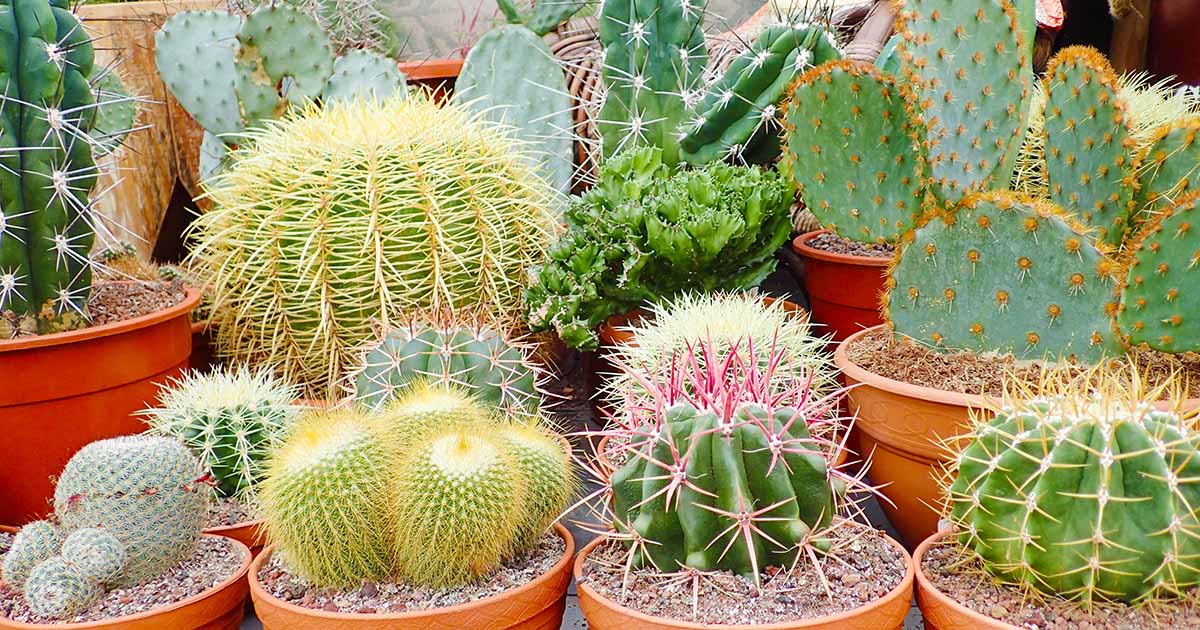
Cacti are succulents in the Cactaceae family that grow outdoors in Zones 9 to 11 and elsewhere as houseplants.
They typically have fleshy stems for storing moisture, a necessity in their native arid habitats. Sharp spines and a lack of leaves distinguish most types from other succulent species.

We link to vendors to help you find relevant products. If you buy from one of our links, we may earn a commission.
As houseplants, cacti are low-maintenance, water-wise choices. In our guide to growing and caring for succulents, we discuss all you need to know to cultivate your own plants.
This article focuses on how often you should water potted cacti.
Here’s what we’ll cover:
How to Water Cactus Houseplants
Let’s start with cultural requirements.
Replicating a Natural Habitat
In nature, most types tolerate full sun enduring extreme heat and dry weather until a burst of rain soaks the parched ground.
Then their roots take up as much moisture as they can for storage in the stems’ spongy flesh, where it is kept and used as needed.

Indoors, growers provide bright, indirect sunlight for optimal exposure without the risk of burning tender stems.
An ideal pot for growing these plants is porous and has at least one drainage hole to allow excess moisture to evaporate or drain away. If it has a drip saucer, this should be drained immediately after watering to avoid oversaturation.
The potting soil should contain organic and inorganic ingredients and be light, airy, moisture-retentive, and well-draining.
An excellent product to try is Hoffman’s, which contains compost, peat moss, sand, and limestone to regulate the acidity.
Each ingredient contributes to a healthy, well-draining growing environment.
Hoffman’s Cactus and Succulent Soil Mix
Hoffman’s Organic Soil Mix is available from Hoffman via Amazon.
With optimal sun exposure plus a suitable pot and soil mixture, the next cultural requirement is water.
Please see our guide to the best water for succulents to learn about the pros and cons of using distilled, municipal, purified, and well water.
Although they have low nutrient requirements, container-grown specimens may benefit from low doses of liquid plant food during the spring and summer active growth periods.
A product with a lower percentage of nitrogen and higher percentages of phosphorus and potassium supports strong roots and efficient moisture uptake.
A product you may like is this formulation from Espoma that has an N-P-K ratio of 1-2-2. It also contains beneficial microbes.
Espoma Organic Cactus Plant Food
This product is available from Espoma via Amazon.
Gauging Moisture Requirements
Houseplant growers like me often wish we could do a one-size-fits all once-a-week watering of all our plants.
Wouldn’t it save time and take the guesswork out? Unfortunately, it’s impossible because each species has unique moisture requirements that must be evaluated individually.

It varies as a result of numerous factors, including temperature, species, soil, size, light, health, container material, and age.
Two seemingly identical specimens are very likely to need water at different times.
Fortunately, although there are nearly 2,000 cactus species in the world, it is possible to know exactly when to water them.
No matter what types you are growing, these moisture-storing powerhouses don’t need watering until the soil in the pot is completely dry.
The trick is to know when the pot is dry, and the best way to gauge moisture content is with a moisture meter. Alternatively, you can check it with a natural wood chopstick.
Now, here’s the challenge: how often should you check for moisture? This is where many growers, myself included, have erred and ended up losing plants.
Just because desert flora is low-maintenance and water-wise does not mean it can tolerate neglect. My recommendation is to check pots less than six inches in diameter every three days and those six inches and larger, weekly.
Gradually, you’ll get to know your plants’ habits and begin to anticipate their moisture needs.
How to Water Cacti
The last topic of our discussion is ways to water. Because they are prone to rotting under excessively moist conditions, it’s important to avoid allowing the stems and spines to get wet.

If you’re using a watering can or kitchen faucet, aim the stream of water at the soil level and continue until the excess drips from the drainage hole in the bottom of the pot.
Since there should be at least two inches between the container rim and the root mass, it should be easy to position a spout over the soil without wetting the spines or stems.

Alternatively, you can use the bottom watering method. To do this, place a pan or deep drip saucer containing two to three inches of water beneath a pot and let it “drink” as much as it can in 20 to 30 minutes.
Use a moisture meter to ensure that the top inch of soil is wet. If it’s not, repeat the process.
When you are finished, do not leave the pot sitting in water, but instead remove it and allow any excess to drip out.
You can learn more about how to bottom water houseplants in our guide.
Both delivery methods use the “dry and soak” style in which a pot completely dries out before thoroughly soaking it.
Resist the temptation to sprinkle a pot lightly when watering other plants, as the frequency of this delivery style may cause oversaturation.
How Dry I Am
The answer to the question, “How often should you water a cactus?” is as often as the soil in the pot is completely dry.

It’s all too easy to forget about plants with a high drought tolerance, so check them regularly, because even the water-wise get thirsty.
Do you grow cacti? Please share your tips in the comments section below.
If you found this article informative and want to learn more about cactus care, we recommend the following:








